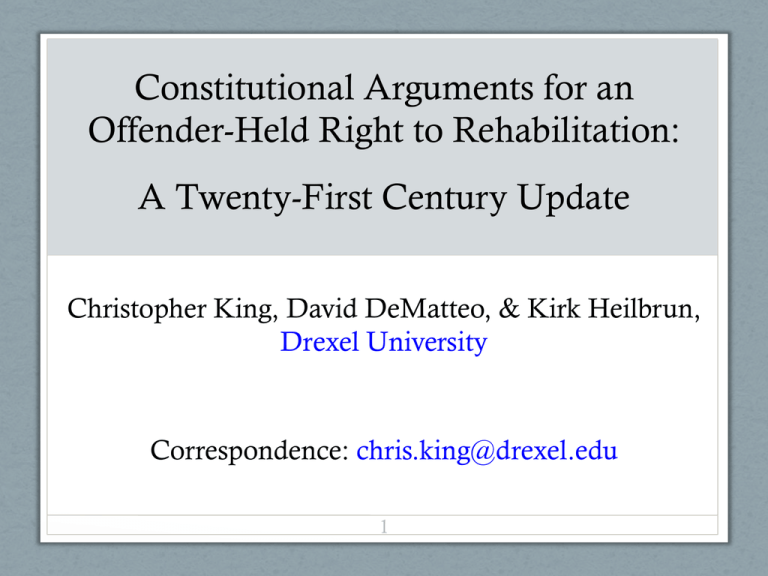Constitutional Arguments for an A Twenty-First Century Update
advertisement

Constitutional Arguments for an Offender-Held Right to Rehabilitation: A Twenty-First Century Update Christopher King, David DeMatteo, & Kirk Heilbrun, Drexel University Correspondence: chris.king@drexel.edu 1 Presentation Outline 1. Empirical context (what is known) 2. Normative context (what could/should be) 3. Constitutional law context and recent developments 4. Alternative legal avenues 5. Proposed right and recommendations for future research 2 Empirical/Positivist Context § Recidivism entails substantial tangible and intangible costs § Impact of different sentencing strategies on recidivism (deterrence, rehabilitation) § Incarceration (deterrence or incapacitation?) effect on aggregate crime rates § Comparative law – US (cf. UK, Netherlands) – Germany (cf. France, Spain, Italy) 3 Normative Context § Many valid but competing utilitarian and non-utilitarian sentencing justifications and limiting principles – Necessitates reconciliatory model (e.g., limited retributivism) § Analogous right-to-healthcare theorizing: 1. Take as given that right to healthcare exists 2. Argue for/against existence on various ethical grounds 3. Take position that it’s impossible to determine whether there is right to healthcare or that inquiry doesn’t matter because fails to resolve most significant policy issues § Analogous theorizing in civil commitment context (see Slobogin et al., 2009) 4 Procedural and Substantive Due Process (Fifth and Fourteenth Amendments) Procedural Due Process: 1. At least in indeterminate sentencing contexts, may exist opportunity for release predicated on positive behavioral change à 2. Behavioral change difficult for offenders/non-offenders alike but facilitated by psychosocial interventions à 3. Should enjoy procedural due process right to receive rehabilitation services to allow them to rehabilitate if offered opportunity for earlier release for demonstrating indicia of rehabilitation (e.g., sufficient reduction in risk) • Cautiously draw analogy to juveniles, sexually violent predators, and offenders with mental illness 5 Procedural and Substantive Due Process (Fifth and Fourteenth Amendments) Substantive Due Process: 1. Rehabilitation has historically imbued in tradition of American corrections à 2. Humanism, liberty-centeredness, and progressiveness point to ordered liberty and justice necessarily entailing recognition of right to rehabilitation à 3. Narrowly construed right implicates fundamental liberty interests in safety, freedom from personal restraint, and avoiding deterioration 4. Offender rehabilitation is a substantive right supported by nation’s history and traditions and/or necessarily included amongst concepts of liberty and justice Procunier v. Martinez (1974), O'Connor v. Donaldson (1975), Youngberg v. Romeo (1982), Sandin v. Conner (1995), Kansas v. Hendricks (1997), Kansas v. Hendricks (1997) and progeny, Washington v. Glucksberg (1997), Lawrence v. Texas (2003) 6 Equal Protection (Fifth and Fourteenth Amendments) 1. Contrast offenders with non-prisoner general public (not blocked from obtaining human services (negative right) or may be due protection from the state under parents patriae (positive right)) à 2. Or contrast offenders with civilly committed persons/NGI/GBMI à 3. Rebut all purportedly rational rationales for treating prisoners different on point of rehabilitation • Significant roadblocks for equal protection = 1. Difficulty in identifying similarly situated class enjoying right 2. High deference (rational basis) paid to most governmental classifications – But could argue offenders deserving of heightened scrutiny review due to immutable characteristics, political weakness, and history of discrimination/prejudice/abuse O'Connor v. Donaldson (1975), City of Cleburne v. Cleburne Living Center, Inc. (1985), Heller v. Doe (1993) 7 Cruel and Unusual Punishment (Eight Amendment) Eight Amendment Categorical Exclusion Analysis: 1. Indicia-of-society’s-views prong: Pursuit of sustainable public safety by including offender rehabilitation amongst penal goals = widely recognized societal standard approaching national consensus à 2. Court’s independent-judgment prong: – Biopsychosocial knowledge of forces that contribute to crime at individual level (e.g., risk factors) discredit offender demonization – Nothing lost with respect to other penal goals when exclusion of rehabilitation forbidden – Provision of human services is practically feasible and cost effective – Little evidence to support fear of litigation floodgate Robinson v. California (1962), Roper v. Simmons (2005) and progeny 8 Alternative Legal Avenues 1. Right under federal constitution admittedly visionary 2. State constitutions represent less lofty prospect (e.g., Alaskan and West Virginian courts have recognized; Abraham v. State, 1978; Cooper v. Gwinn, 1981) • Left for another day are reexaminations of other possibilities rooted in: 3. International law 4. Administrative law 5. Contractual law 6. Tort law 7. Disability law (e.g., Americans with Disabilities Act; e.g., Pennsylvania Dep’t of Corr. v. Yeskey, 1998; United States v. Georgia, 2000) 9 Future Directions: Proposed Right to Rehabilitation A jurisdiction is required to include among its penal goals the reasonable pursuance of normative, reasonable, public-safety-focused rehabilitation services and opportunities for each person subject to correctional authority. Persons subject to correctional authority enjoy the positive waivable right that rehabilitative efforts of this type be reasonably undertaken on their behalf rather than an absolute right to be rehabilitated. • Some practical concerns alleviated by formulation’s 1. Allowance for other penal goals to be pursued (but never to extent that rehabilitation goal is unreasonably chilled) 2. Caveat that articulated right not an absolute right to be rehabilitated 3. Affordance to each offender unilateral power to waive right 10 Normative and Empirical Questions A. Whether decisions regarding constitutional rights should/could be evidence-based? B. Whether rehabilitation is better construed as government interest v. individual right (or both)? C. Whether judicial progressivism (versus democratic and administrative processes) is desirable and realistic? 1. Financial implications for correctional systems? 2. Corrections variables that facilitate offender rehabilitation v. make offenders worse? 3. Public’s and policymakers’ ethical and evidentiary thresholds for being persuaded it is worth committing to burden of delivering correctional rehabilitation? 11 Additionally Available Information and Gratitude • Reference list available upon request • Manuscript to be submitted for publication in near future • Thanks to the anonymous reviewers and Conference Advisory Committee 12




